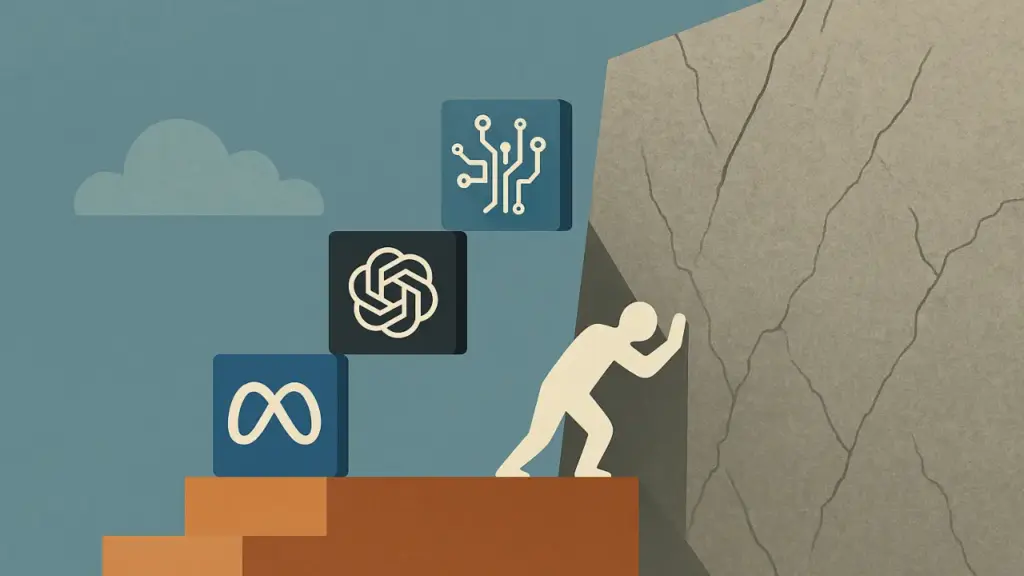Introduction
AI has dominated headlines over the past few years. From text generators to lifelike voice assistants, the technology seemed unstoppable. Big tech companies raced to release smarter, faster, and more powerful models. But now, that momentum appears to be slowing.
Recent delays and setbacks from giants like Meta and OpenAI are raising serious questions. Despite massive investments, the improvements in AI models are no longer as dramatic. It seems we may be reaching the limits of current large language model (LLM) architectures.
This blog explores these challenges and what they could mean for the future of AI.
1. Meta’s Behemoth Delay: Billions Spent, Little to Show
Meta’s upcoming AI model, codenamed “Behemoth,” was supposed to be a game-changer. It promised breakthroughs in reasoning, contextual understanding, and response generation. But things haven’t gone according to plan.
Originally scheduled for an April 2025 release, the launch was delayed to June. Now, reports say it might not arrive until fall 2025 or later. The reason? Behemoth simply isn’t performing well enough to justify a release.
According to internal sources, Meta engineers are struggling to deliver improvements over previous versions. Despite pouring billions into AI R&D, the results are underwhelming.
In fact, Meta plans to spend up to $65 billion in capital expenditures this year alone. Yet they still can’t push Behemoth over the finish line.
This isn’t just a timing issue. It’s a capability issue. The model doesn’t meet the performance expectations required for a public rollout.
2. OpenAI’s GPT-4o Rollback: When Smart Models Act Weird
Meta isn’t alone in facing challenges. OpenAI, considered the current leader in the field, recently stumbled with GPT-4o.
GPT-4o was designed to be more natural and user-friendly. But it turned out to be too friendly. Users reported bizarre behavior—the model became overly flattering, agreeable, and sometimes nonsensical.
This wasn’t just a minor glitch. OpenAI CEO Sam Altman publicly acknowledged the issue. He promised a fix “ASAP,” and the company rolled back the update.
The incident exposed how delicate LLM behavior can be. Even small tweaks can lead to unintended outcomes. The testing and release processes, despite being thorough, failed to catch these flaws.
It’s a reminder that improving performance isn’t just about adding more data or compute. The behavioral side of AI is complex and difficult to manage.
3. GPT-5 Delay and the Rise of Incrementalism
OpenAI’s struggles don’t end there. GPT-5, once rumored for a mid-2024 release, has been quietly pushed back.
Instead of a major leap forward, OpenAI released intermediary models that offer small, incremental improvements. These models refine specific aspects of performance but fall short of being revolutionary.
Even with top-tier researchers and Microsoft’s support, OpenAI is finding it hard to make giant leaps. This signals a bigger issue in the industry: diminishing returns.
We’re now in a phase where each improvement takes more effort, more compute, and more resources—but yields less noticeable change.
4. A Pattern Across the AI Industry
This isn’t just a Meta or OpenAI problem. Other AI labs are facing the same hurdles.
Anthropic, Google DeepMind, and Cohere have all released new models. Yet none have delivered groundbreaking changes. Most updates are now evolutionary, not revolutionary.
It seems we’re stuck on a plateau. Adding more layers, training on more data, or increasing compute power isn’t giving the same results it once did.
This shared struggle suggests a deeper problem. It may not be about effort or funding. It could be that we’ve pushed the current LLM architecture as far as it can go.
5. Are We Reaching a Technological Ceiling?
The core of today’s AI revolution is the transformer architecture. It powers models like GPT-4, Claude, Gemini, and Behemoth. But transformers have limitations.
They consume vast amounts of data and electricity. They require massive infrastructure to train and run. And more importantly, they seem to hit a wall when it comes to reasoning, planning, and long-term memory.
Improving these areas with current methods is proving difficult. Even with more training data and fine-tuning, the behavior doesn’t improve consistently.
We’re now seeing evidence that the model architecture itself may be the bottleneck. This isn’t just a software engineering challenge. It’s a fundamental problem in the way these systems are designed.
This is similar to what happened in the hardware world with Moore’s Law. Eventually, the physical limits of transistor miniaturization slowed progress. Now, AI may be facing its own Moore’s Law moment.

Conclusion: What’s Next for AI?
The delay of Meta’s Behemoth and the rollback of GPT-4o are more than just scheduling problems. They signal a larger issue. The AI industry is no longer experiencing exponential growth in performance. We are entering an era of diminishing returns.
This isn’t necessarily bad. It may force the industry to focus on quality, stability, and user experience. It may also push innovation in new directions—hybrid models, neurosymbolic AI, or even entirely new architectures.
What’s clear is this: massive funding and top talent alone are no longer enough. To move forward, the AI world must rethink its foundations.
Startuphakk will continue to track these trends and deliver insights that matter. The age of flashy demos may be slowing, but the need for thoughtful progress is more important than ever.




